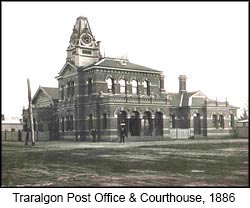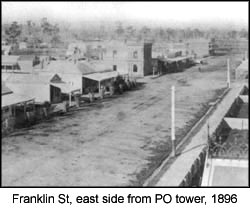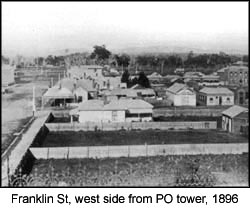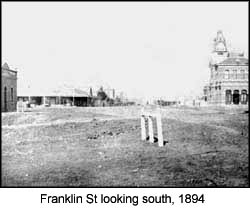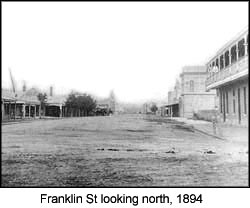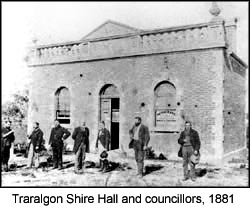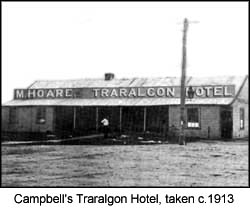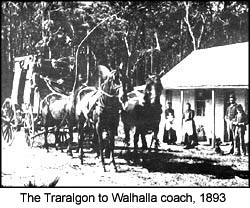Traralgon History |
|---|
A Very Brief History of Traralgon The area around Traralgon was first settled by Europeans in the 1840s soon after being explored by Count Pawel Strezlecki (on his return from the Snowy Mountains, where he named Australia's highest peak (Mount Kosciuszko)). Count Strezlecki was very impressed with the region through which he'd passed, and told others about the fertile land. It didn't take long for farming, mostly dairy, to become established. The Traralgon township was established in the early 1860s. Duncan Campbell built The Travellers' Rest Hotel west of the Traralgon Creek just prior to that. The Hotel served as the general store, post office, and community centre, where court proceedings, as well as church services, were held. It performed many of these functions for 60 years, until it was demolished in 1914 to make way for the Traralgon Hotel, the building that would later go on to be called Ryan's. In 1877 Traralgon was given a major economic boost, when the railway line from Melbourne was completed and Traralgon Railway Station was built. Franklin Street became the town hub. Traralgon was part of the area administered by the Rosedale Roads Board, before the Shire of Traralgon (whose boundary ran to the Morwell river) was established in 1879. The Traralgon Courthouse and Post Office complex was built in 1886. In 1888, the second Mechanics Institute was built on Hotham St. Later, the town hall and council office adjoined it. Photo Sadly, the complex was demolished in 1972. DPI now uses the site. In the 1930s, Traralgon began to move away from a farming-based economy. In 1936 Australian Paper Manufacturers established a paper mill at Maryvale, just outside of Traralgon. Many employees of the APM lived in Traralgon, where the company built homes for some of them. 1936 aerial photo of Traralgon Through the 1950s, residents and councillors fought to separate the urban areas of Traralgon from the Shire of Traralgon. This didn't occur until 1961, when Traralgon formed its own borough, the Borough of Traralgon. Traralgon was granted "City" status in 1964. Further development resulted from the expansion of the power generation industry following World War II, particularly through the now-defunct State Electricity Commission of Victoria. This included large expansions at Yallourn and Hazelwood Power Stations and the construction of the massive Loy Yang Power Station in the 1970s and 1980s. Completion of the Loy Yang power stations, extensive voluntary departures from, and privatisation of, the Victorian electricity industry in the early 1990s had devastating effects upon the economy of the Latrobe Valley. Traralgon, with a more diversified economy than its neighbouring towns, fared somewhat better, as it was less dependent upon the power industry for employment. An Australian Securities Commission information processing centre was established on Grey Street in the early 1990s, at the time employing around 400 people. The Federal Government built the Centrelink call centre on Princes Highway in Traralgon in the late 1990s, also employing several hundred people. In 1994, Traralgon, along with the Cities of Morwell and Moe, as well as Traralgon Shire, and parts of the Shires of Narracan, Mirboo North, and Rosedale, were compulsorily amalgamated by the Kennett government to become "Latrobe City". Many people were very unhappy about being forced to merge, and having their democratically-elected governments dismissed without their consent. In response, they were told that the amalgamation would be reviewed at a later date, to see how it was working (that never occurred). At first the new City was administered from Traralgon. It would come to pass that new Council offices would be built in Morwell, at great cost to the ratepayers of the City (and especially Traralgon). Those who questioned the enormous cost or necessity of a new building were threatened by then-Cr Brendan Jenkins with being declared "vexatious" if they joined in an application for review by VCAT. The new Council HQ was meant to help revitalise Morwell, but it fell somewhat short of that goal. In Latrobe City, Traralgon and its districts were divided across four wards. Some believed this was done to diminish any influence Traralgon would have had in Council votes. This unfortunate situation split many "communities of interest" apart, in contravention of the Victorian Electoral Commission's own rules. Many Traralgon residents found it upsetting that Councillors from the wards outside Traralgon, who appeared to have their own agendas, were in a position to make major decisions which were detrimental to Traralgon. The straw that broke the camel's back, so to speak, was Council's last-minute decision to build the new Performing Arts Centre in Morwell, after a nearly $100,000 study and against the advice of its own Council officers, who'd recommended Traralgon. This caused outrage in the Traralgon community, and caused the secession movement to gain momentum. The plan to sell the Traralgon swimming pool (which had been paid for in the 1950s by residents' donations) - as well as other projected works listed in the proposed "Traralgon Activity Centre Plan", only served to inflame the issue. In response to a residents' petition in 2011, Latrobe City's internal boundaries received a complete review, in lieu of secession. Both the Minister for Local Government, and the VEC encouraged citizens to get together to do "quality" submissions, and the TCDA joined with the Moe and District Residents Association (MADRA) to plan a new model for Latrobe City's wards. In March 2012, the VEC approved a modified version of the joint TCDA/MADRA model, and that took effect after the Council elections in October 2012. It's funny to think that back in 1890, when Traralgon and Morwell were previously "joined", Morwell was desperate to secede. They believed that they paid more in rates than Traralgon did, and were furious when, despite intensive lobbying, it was decided that the new shire hall would be built in Traralgon. Their campaign, which was ultimately successful, went on for years: "The Morwell people were still trying to get their own Shire. They had a petition drawn up for all to sign, and they insisted that anyone who signed it paid one shilling towards the cost of sending a deputation to Melbourne with the petition...They were complaining that half the rates of the Traralgon Shire came from the Morwell and Mirboo areas, yet they had only three Councillors out of the nine. " - W. Cuthill, in his book about the History of Traralgon, "The River of Little Fish" (quoted with permission of the Traralgon Historical Society). For more information on Traralgon's history, please visit the Traralgon Historical Society's website here.
|
||||
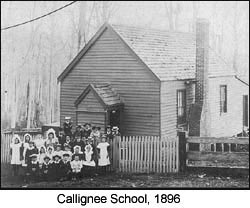 |
||||
All photos used with permission from The Traralgon Historical Society. |
||||
